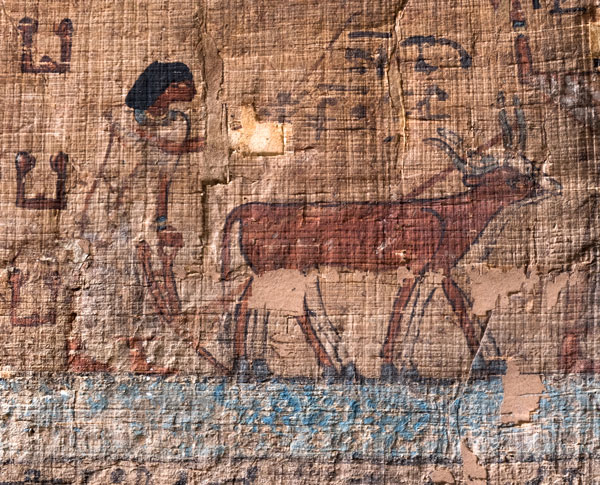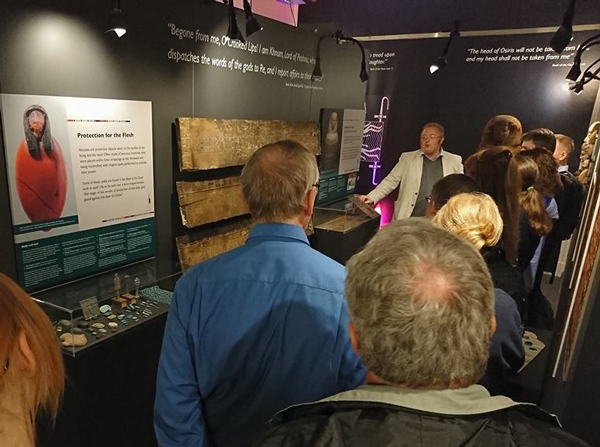
One of the things I have always been keen to explain, as both an Egyptologist and curator is that despite the popular view of the Egyptians as a civilisation obsessed with death, this is not exactly the case. They were obsessed with life.
And this obsession inspired them to come up with more and more ways of triumphing over death, from mummification of the body to magical spells to defeat the demons guarding the gates of the Underworld.
After death, ancient Egyptians believed that their souls went on a journey into the Underworld, a space beneath the earth through which the sun travelled at night. This path through the Underworld, called the ‘Hours of the Night’ was fraught with danger, and magical tools would be needed to survive its many hazards.
To help them on their way, Egyptians were buried with amulets, as well as underworld diagrams and collections of magic spells, such as those known today as the 'Book of the Dead'.
After the perils of the Underworld came judgement: the heart of the dead person was weighed against the feather of Truth. Only if their conduct had been blameless could they enter the Field of Reeds, the paradise-like domain ruled over by Osiris, god of the dead.

Bringing the Book of the Dead to life
In May 2017, for Light Night, the Garstang Museum unveiled a special exhibition focussed on our Ancient Egyptian 'Book of the Dead' fragments - this exhibition is now on show at the Victoria Gallery & Museum until September 2018. The purpose of the exhibition is to show how ancient Egyptian ideas about the afterlife inspired them to create ever more sophisticated tools to help them achieve an eternal life.
It's a great opportunity for us to display objects never seen before by the public, including papyri, ancient coffins, and magical amulets, as well as iconic photography of ancient papyri. The exhibition begins with a practical guide to navigating the ancient Egyptian underworld, with displays of the ancient papyri, coffins and amulets used as tools by the Egyptians to get them through the night, and into eternity.
Egyptian Surrealism and 'surreal Egyptology' at Tate Liverpool
On hearing about the recently opened Egyptian Surrealism exhibition at Tate Liverpool, I thought it was the perfect opportunity to work with the gallery and Egyptology experts from the Archaeology, Classics and Egyptology department to create an activity bridging the gap between Egyptian Surrealism and 'surreal Egyptology'. Surrealism is a Modernist movement, but one that draws in part on the artists’ surroundings, including Ancient Egyptian heritage.

Get involved at Tate Liverpool
From 4-10 December 2017 we're inviting visitors to come to Tate Liverpool and join us on a journey through the ‘Hours of the Night’, where subconscious fears and dreamlike states come together in a dramatic funerary landscape, beautifully captured by work of local photographer and Egyptologist, Julia Thorne.
A video by Leigh Gallagher, who has recently completed a comic strip for 2000AD featuring re-imaginings of Egyptian gods, will take viewers through the process he uses to create his illustrations.
The space will also host objects and images from the Garstang Museum of Archaeology.
Alongside all of this will be a talk by Dr Roland Enmarch, ‘What dreams may come: Ancient Egypt’s surreal underworld’ (from 2pm on 6 and 9 December), and workshops in museum photography by Julia Thorne (from 11am on 7 and 10 Decmber).
Surrounded by all this inspiration, visitors will be able to create their own illustration of actual spells from the Book of the Dead and post their work on a wall in a display running alongside the exhibition at the Tate. They can also snap a picture of their creation and tweet it to us @garstangmuseum or post it on our Facebook page!
We hope that this week of activities will not only to inspire visitors, but encourage them to return and continue to engage with the exhibition, the University, and Tate Liverpool more broadly.
This Tate Exchange project is a collaboration between the department of Archaeology, Classics and Egyptology, The Garstang Museum, Tate Liverpool, Julia Thorne and Leigh Gallagher.
Keep on exploring
- More about our Book of the Dead events and the Tate Exchange project
- Learn more about studying Egyptology